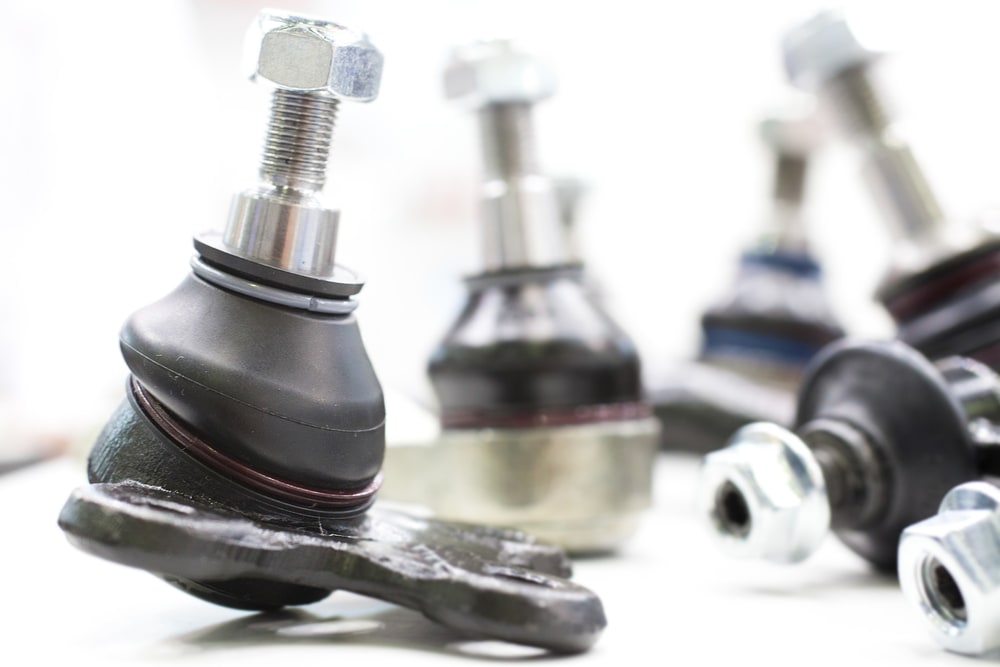

What is a Ball Joint?
Ball joints are an important suspension component found on virtually all modern vehicles. They are a spherical bearing in a socket — functioning similarly to the ball and socket design of a human hip — and serve as one of the main suspension pivot points connecting the control arms of the vehicle to the steering knuckles. The front ball joints allow the front wheels and suspension to move back and forth as well as up and down when the steering wheel is turned and the vehicle is traveling over the road.
Should a ball joint break, the wheel becomes totally free to move in any direction, which can damage the car’s fender, tire, and several suspension components, if not more.
So how do you know if your ball joints are bad?
Usually, when the front ball joints start to fail, the vehicle will display a few symptoms that alert the driver that a problem has occurred. We’ve compiled a list of 4 symptoms below that can indicate a failing ball joint.
1. Clunking Noises From the Front Suspension
One of the most common symptoms of a bad ball joint is clunking noises coming from the vehicle’s front suspension. As ball joints wear out they become loose in the socket and rattle, squeak, and sometimes even knock as the suspension travels up and down over the road. Worn ball joints will make noise when traveling on rough roads, speed bumps, or when turning. Usually, the noise will get continuously louder as the ball joints wear out, or until they eventually completely fail and break. If your ball joint breaks you may lose control of your vehicle so getting them inspected and repaired is extremely important.
2. Excessive Vibration From the Front of the Vehicle
Another sign of a failing ball joint is excessive vibration coming from the vehicle’s suspension. Worn ball joints will be loose in their sockets and vibrate disproportionately as the vehicle is in motion. The vibration will usually stem from the affected ball joint, either from the right or left sides of the vehicle. In some cases, the vibration may be felt through the steering wheel as well.
3. Uneven Wear on Front Tires
The inner or outer edges of your front tires wearing down quicker than the rest of the tread can also be a sign of a failing ball joint. This symptom can be difficult to catch; if you become aware of any other signs of ball joint failure, check your tires carefully and pay close attention to the inner treads. Wear must appear on either the inner or outer tread, not both, to signify worn-out front ball joints. Under-inflation of tires will cause both edges to wear out faster.
4. Steering Wheel Wandering to the Left or Right
Another symptom of bad ball joints is wandering steering. Wandering steering is when the vehicle steering drifts from left to right on its own. When the ball joints are in good condition and the wheels are in proper alignment, the steering wheel should stay mostly straight and direct in response. Worn ball joints will cause the vehicle steering to wander to the left or right, which will require the driver to compensate for the issue.
Can You Drive on Bad Ball Joints?
Driving on bad ball joints is highly risky and not recommended. Bad ball joints can lead to poor vehicle control, unpredictable steering, and potential loss of control, especially during turns or sudden maneuvers. Continued driving on bad ball joints can result in severe damage to other suspension components, posing a safety hazard to you and other road users. It is crucial to address any symptoms by checking your ball joint or seeking professional inspection and replacement to ensure your vehicle's safety and optimal performance. If you decide to take this on yourself, make sure you check out our guide on how to use a ball joint press to ensure safety and success when replacing a ball joint.
Ball joints are an important component of any vehicle’s suspension. When they begin to have problems or fail, the overall handling and ride characteristics of the vehicle are likely compromised. It’s also important to know the signs of a failing rear ball joint to ensure safety. If you suspect that your vehicle’s ball joints have become severely worn or need to be replaced, have the vehicle’s suspension inspected by a professional technician to determine what the best course of action may be. If necessary, they will be able to replace any failing balljoints for you.



